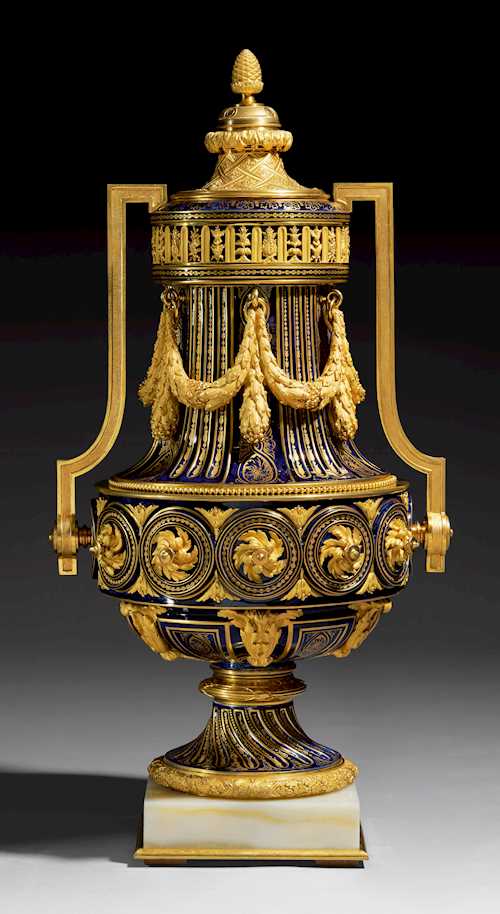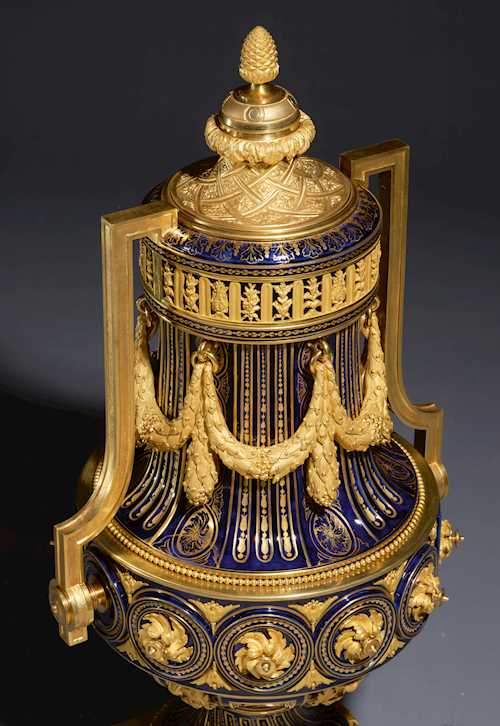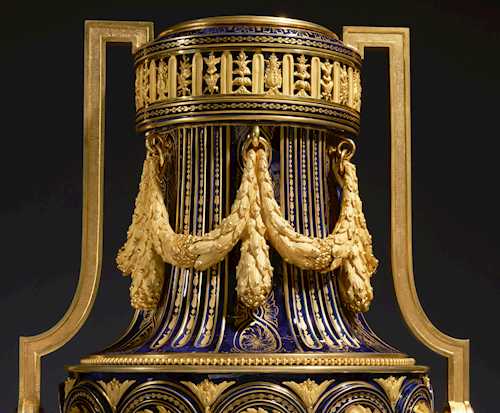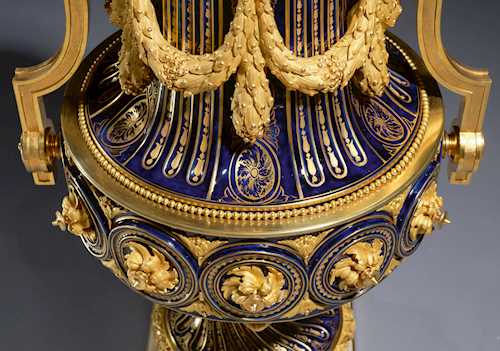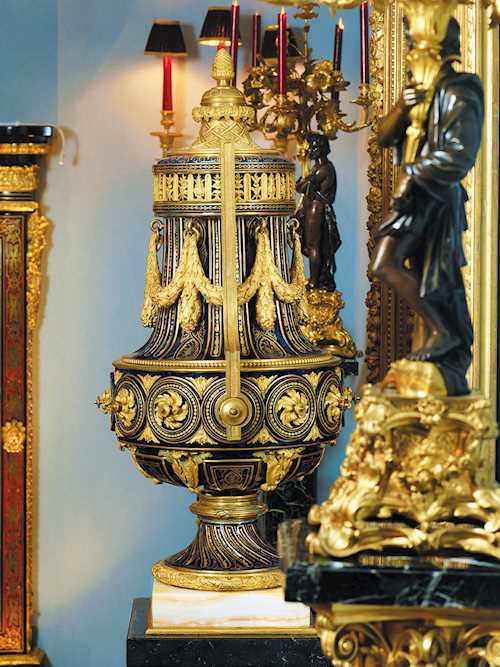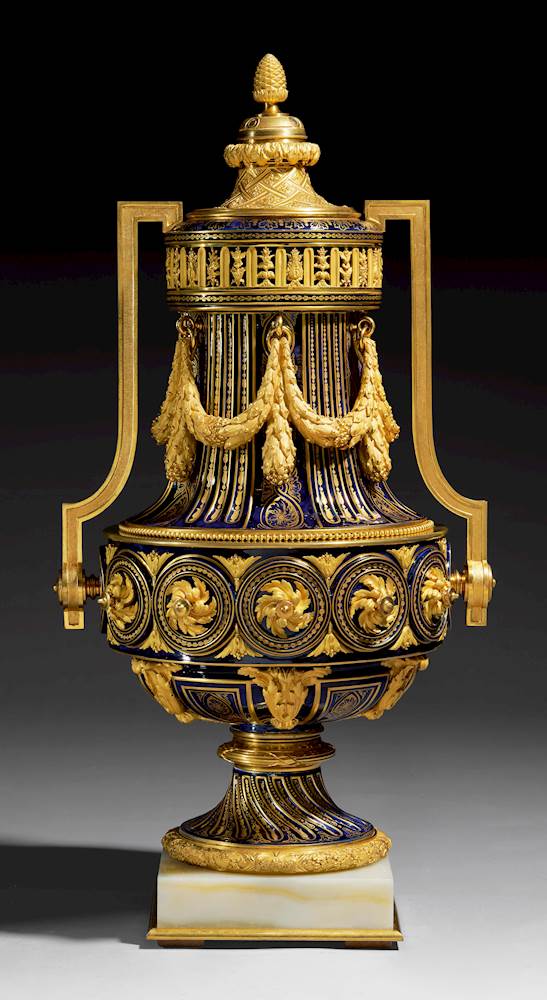
Lot 1045* - A211 Glamour and Sophistication: Luxury in 19th-Century Paris - Thursday, 28. November 2024, 10.00 AM
A MONUMENTAL PORCELAIN LIDDED VASE “GREC À ROSETTES” WITH GILT BRONZE MOUNTS
Louis XVI style, France, 19th century. Based on a model from the Sèvres porcelain factory, probably by Jean-Claude Duplessis (ca. 1695–1774) from 1765. The bronze mounts partly monogrammed CL on the back.
Cobalt blue glaze with gold decoration. Urn shape with a wide, continuous frieze of medallions in relief, and a conically indented, partly gadrooned neck, on a chalice-shaped base with a gadrooned spiral pattern. Gilt bronze mounts in the form of laurel garlands, rosettes, pearl frieze, flowers, oak-leaf frieze, and a pine-cone finial. Distinctive, gilt bronze handles. On a square onyx plinth.
H 105 cm, Ø 50 cm.
Bronze mounts cleaned, with a few scratches. Gilding somewhat rubbed. Gilding on the paintwork rubbed in some places. Lid finial slightly bent.
This model, a “vase grec à rosettes” in a 19th-century version, is based on a vase model from the Louis XVI period, which was presumably designed by Jean-Claude Duplessis (1695–1774) in 1765 for the Sèvres Manufactory (see M. Brunet and T. Préaud: Sèvres des origines à nos jours. 1978, p. 203, fig. 236). The design of the vase reflects the neoclassical influence that came into fashion in the 1760s and was rediscovered and popularized at the end of the 19th century during the “neo” styles.
Painted in various background colors typical of the 18th century, a pair glazed in the characteristic “bleu nouveau” can be found in the Wallace Collection in London (Inv. Nos. C272-3 and C272-5) and another pair “au fond pointillé rose” in the Rijksmuseum in Amsterdam (Inv. No. BK-17515-A).
The fame of the royal Manufactory spread as far as Russia. When Grand Duke Paul of Russia (1754–1801), the future Tsar Paul I, and his wife Maria Feodorovna (1759–1828), née Sophie Princess of Württemberg, visited the French court in 1782, they were shown around the porcelain manufactory in Sèvres, where Louis XVI gave them a generous gift in the form of numerous porcelain pieces. The royal couple themselves subsequently acquired many more pieces, including a pair of these popular vase models, which are apparently still in Pavlosk Palace today (see Rijksmuseum Inv. No. BK-17515-A, note).
A direct comparison for the model on offer, with identical bronze mount, similar size, color scheme and design, can be found in one of the reception rooms of the Dolmabahçe Palace in Istanbul. This magnificent building is one of the most monumental structures on the banks of the Bosporus and was built between 1843 and 1856 by the famous Balyan family of architects, who incorporated both Ottoman and Western stylistic elements. The French influence on the design of the interior is a result of the intensive artistic relations between France and the Ottoman court during this period. The palace owes its French flavor to the work of the Parisian decorator Charles Séchan (1803–1874), who selected exquisite French furniture and magnificent Sèvres porcelain for the palace (see Xavier du Crest: De Paris à Istanbul, 1851–1949. Un siècle de relations artistiques entre la France et la Turquie, 2009).
Numerous variations were created following Duplessis's example, including a monumental vase chandelier made of Algerian onyx, designed by Eugène Cornu (1827–1899), which can be seen in an engraving by D. Lancelot for the stand of the “Société des marbres et onyx d'Algérie” at the 1878 Paris World's Fair. Another example of a vase-chandelier is known from a photograph of the Cornelia M. Stewart House in New York (demolished in 1901).
Also worth mentioning is the monogram “CL”, which can be seen on the back of some of the bronze mounts of the vase on offer. Due to a lack of scientific research, only a few of these marks, which can be found on bronze furniture fittings from the 19th century, have been identified. The monogram “CL” on our ornamental vase therefore remains a mystery. It could be a patron's monogram or an inventory number, but most likely it is the monogram of a bronze caster.
This model, a “vase grec à rosettes” in a 19th-century version, is based on a vase model from the Louis XVI period, which was presumably designed by Jean-Claude Duplessis (1695–1774) in 1765 for the Sèvres Manufactory (see M. Brunet and T. Préaud: Sèvres des origines à nos jours. 1978, p. 203, fig. 236). The design of the vase reflects the neoclassical influence that came into fashion in the 1760s and was rediscovered and popularized at the end of the 19th century during the “neo” styles.
Painted in various background colors typical of the 18th century, a pair glazed in the characteristic “bleu nouveau” can be found in the Wallace Collection in London (Inv. Nos. C272-3 and C272-5) and another pair “au fond pointillé rose” in the Rijksmuseum in Amsterdam (Inv. No. BK-17515-A).
The fame of the royal Manufactory spread as far as Russia. When Grand Duke Paul of Russia (1754–1801), the future Tsar Paul I, and his wife Maria Feodorovna (1759–1828), née Sophie Princess of Württemberg, visited the French court in 1782, they were shown around the porcelain manufactory in Sèvres, where Louis XVI gave them a generous gift in the form of numerous porcelain pieces. The royal couple themselves subsequently acquired many more pieces, including a pair of these popular vase models, which are apparently still in Pavlosk Palace today (see Rijksmuseum Inv. No. BK-17515-A, note).
A direct comparison for the model on offer, with identical bronze mount, similar size, color scheme and design, can be found in one of the reception rooms of the Dolmabahçe Palace in Istanbul. This magnificent building is one of the most monumental structures on the banks of the Bosporus and was built between 1843 and 1856 by the famous Balyan family of architects, who incorporated both Ottoman and Western stylistic elements. The French influence on the design of the interior is a result of the intensive artistic relations between France and the Ottoman court during this period. The palace owes its French flavor to the work of the Parisian decorator Charles Séchan (1803–1874), who selected exquisite French furniture and magnificent Sèvres porcelain for the palace (see Xavier du Crest: De Paris à Istanbul, 1851–1949. Un siècle de relations artistiques entre la France et la Turquie, 2009).
Numerous variations were created following Duplessis's example, including a monumental vase chandelier made of Algerian onyx, designed by Eugène Cornu (1827–1899), which can be seen in an engraving by D. Lancelot for the stand of the “Société des marbres et onyx d'Algérie” at the 1878 Paris World's Fair. Another example of a vase-chandelier is known from a photograph of the Cornelia M. Stewart House in New York (demolished in 1901).
Also worth mentioning is the monogram “CL”, which can be seen on the back of some of the bronze mounts of the vase on offer. Due to a lack of scientific research, only a few of these marks, which can be found on bronze furniture fittings from the 19th century, have been identified. The monogram “CL” on our ornamental vase therefore remains a mystery. It could be a patron's monogram or an inventory number, but most likely it is the monogram of a bronze caster.
CHF 60 000 / 80 000 | (€ 61 860 / 82 470)

